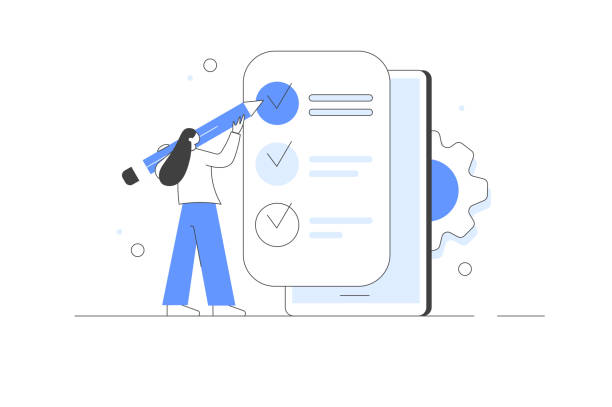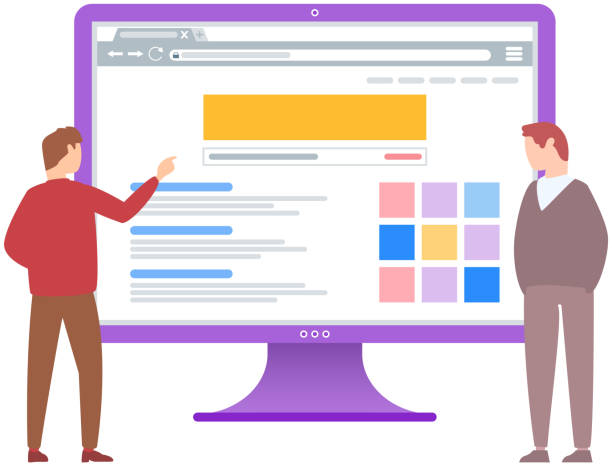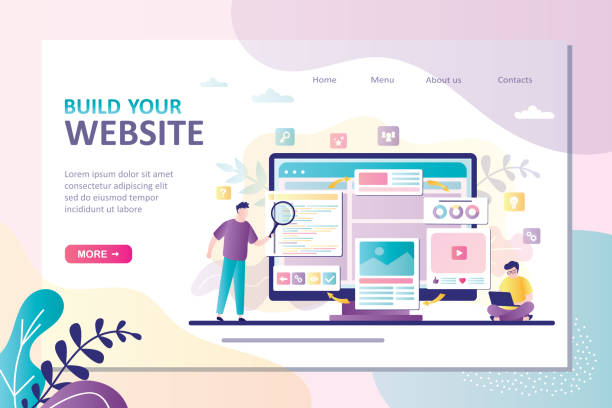The Importance and Necessity of Multilingual Website Design in the Global Era

In today’s world, where geographical boundaries have faded and global communications have peaked, an online presence has transitioned from an option to a necessity.
One of the most important steps to expanding this presence is multilingual website design.
This action not only enables businesses to attract more audiences from around the world but also demonstrates respect for users’ cultural and linguistic diversity.
When a website is available in multiple languages, users from different parts of the world can easily engage with your content and receive the information they need in their native language.
This approach is especially crucial for companies looking to export products and global services.
A single-language website limits you to a small segment of the market, whereas multilingual website design opens a gateway to broader international markets.
This not only helps increase website visits and traffic but also significantly boosts the conversion rate of visitors to customers.
In this regard, the explanatory section of this article will help you gain a deeper understanding of the various aspects of this topic.
Global presence is a key strategy in the digital age, and multilingual website design forms the backbone of this strategy.
This is a smart investment for your business’s future that can yield tremendous returns.
Did you know that 94% of a first impression of a company is related to its website design?
Rasaweb, by providing professional corporate website design services, helps you create the best first impression.
✅ Create a professional and reliable image for your brand
✅ Easier attraction of potential customers and improved online positioning
⚡ Get free corporate website design consultation
Competitive and Economic Advantages of a Multilingual Website

Entering global markets requires tools that can build a bridge between you and your international audience.
One of the most powerful of these tools is multilingual website design, which brings significant competitive and economic advantages.
The first advantage is increased market reach.
By providing your website content in different languages, you can reach millions of new users worldwide who would otherwise never have access to your content.
This is especially crucial for e-commerce companies and online service providers.
Secondly, it is about improving SEO and search engine rankings.
Local search engines better identify multilingual websites, leading to increased organic and targeted traffic.
When your content is optimized in different languages, you will have a greater chance of appearing in local and international search results.
Thirdly, it is about increasing user credibility and trust.
Providing content in the user’s native language conveys a sense of respect and consideration, and this can become thought-provoking content in the minds of competitors, wondering why they haven’t taken such a step.
Users tend to trust businesses more that put in extra effort to communicate with them.
Additionally, reducing bounce rate (Bounce Rate) and increasing user dwell time on the site are other positive outcomes, as users easily find the content they are looking for.
This analytical and data-driven approach shows that multilingual website design is a strategic investment for long-term growth and sustainability.
Technical and Architectural Aspects for Implementing a Multilingual Website

Implementing a multilingual website is not just about translating content; it requires a specialized approach and consideration of technical and architectural aspects.
There are three main approaches to managing different language versions of a site: Subdirectories, Subdomains, and Top-Level Domains (TLDs).
Each of these methods has its own advantages and disadvantages in terms of SEO, management, and cost.
For example, subdirectories (like example.com/en and example.com/fa) are often preferred for SEO because they share the main domain’s authority.
In contrast, using subdomains (like en.example.com and fa.example.com) or separate domains (like example.co.uk and example.de) might be more suitable for geographical targeting in specific cases.
One of the most important technical considerations is the use of hreflang tags.
These tags help search engines serve the correct language and regional version of a page to the appropriate users.
Incorrect use of these tags can lead to duplicate content issues and a decrease in SEO ranking.
Furthermore, the database architecture must be designed to easily allow for the storage and retrieval of content in different languages.
This includes designing separate tables for translations or using multilingual fields within a main table.
Below is an educational table comparing common URL structures in multilingual website design:
| URL Method | Example | SEO Advantages | Disadvantages |
|---|---|---|---|
| Subdirectory | yourdomain.com/en/page |
Inherits main domain authority, easier management | May require more configuration for more precise geographical targeting |
| Subdomain | en.yourdomain.com/page |
Clearer separation for geographical targeting, separate hosts possible | Requires building separate SEO authority for each subdomain |
| Separate TLDs | yourdomain.de |
Best for precise geographical targeting, each domain has independent authority | Highest cost and management complexity, requires building SEO authority for each domain |
Additionally, the Content Management System (CMS) used must also fully support multilingual capabilities.
Many modern CMSs like WordPress with appropriate plugins or Drupal with built-in features provide this functionality.
The correct choice of architecture and proper technical implementation are the cornerstones of success in multilingual website design.
Search Engine Optimization (SEO) for Multilingual Websites

SEO for multilingual websites has its own complexities that go beyond mere keyword translation.
To ensure your site is visible in global search results, a comprehensive multilingual SEO strategy is essential.
The first step is local keyword research.
Keywords effective in one specific language or culture may not be effective or even have a different meaning in another language.
Therefore, separate keyword research must be conducted for each target language.
Guidance in this area includes using local tools and consulting with local SEO specialists.
The second important aspect is correct geographical and linguistic targeting.
As mentioned in the previous section, using hreflang tags is crucial for signaling different language versions to search engines.
These tags prevent duplicate content issues and ensure that users are directed to the appropriate content version.
Furthermore, high-quality and localized content is of particular importance.
Mere machine translation of content is not enough; content must be localized by native-speaking translators familiar with the target culture, so that it is not only grammatically correct but also culturally appropriate and engaging.
This includes localizing images, currency, dates, and even cultural examples and references.
Thought-provoking content can lead to greater user engagement with your site.
Creating Google My Business profiles for physical locations in each target country can also help with local SEO.
Page Speed must also be optimized for each language, as this factor directly impacts user experience and SEO ranking.
Multilingual website design without a strong SEO strategy is like building an excellent product without marketing it.
Precise and continuous optimization for search engines in all languages ensures that your efforts to go global will succeed and your audience will find you.
Does your company’s website perform as befits your brand? In today’s competitive world, your website is your most important online tool. Rasaweb, specializing in professional corporate website design, helps you to:
✅ Build customer credibility and trust
✅ Convert website visitors into customers
⚡ Get a free consultation!
Content and Translation Management in Multilingual Websites

One of the biggest challenges in multilingual website design is efficient content management and the translation process.
As the number of languages increases, the complexity of content management also grows exponentially.
Choosing a suitable Content Management System (CMS) that fully supports multilingual capabilities is the first step.
Some CMSs, such as WordPress with powerful plugins (like WPML or Polylang) or Drupal and Joomla with built-in multilingual features, facilitate this process.
These systems allow you to link different language versions of a page and maintain organizational integrity.
The translation process itself also requires careful management.
You can use professional human translators who provide the best translation quality and can localize content.
This approach is particularly recommended for sensitive, marketing, and specialized content.
Using machine translation with human post-editing can also increase speed but requires careful review to ensure accuracy and quality.
Translation Management Systems (TMS) are also available to help you organize, track, and manage the translation process.
These tools typically include Translation Memory and Glossaries, which help maintain consistency in translations and reduce costs in the long run.
Your website’s news section should also be updated regularly, and these updates must occur simultaneously in all languages.
For entertaining content, cultural differences should also be considered to ensure it is appealing to the target audience.
In addition to text, translating visual elements such as infographics and videos is also essential to provide a complete user experience.
Effective content management in multilingual website design is key to keeping the site fresh and connected with global audiences.
User Experience and User Interface (UI/UX) Design in Multilingual Websites

User Interface (UI) and User Experience (UX) design in multilingual website design goes beyond merely translating text elements.
This design aspect must consider cultural differences, readability, and user expectations in different languages.
The first and most important point is the Language Switcher.
This selector should be clearly visible, accessible, and have distinct labels (not just flags, as one flag may represent multiple languages or dialects).
Its placement is usually in the website’s header or footer and it should be easy to use.
The second point is responsive and flexible design.
Different languages can have different lengths for a similar phrase.
For example, an English word might become a longer phrase in Persian or German.
Therefore, the design must provide sufficient space for text expansion to prevent clutter or content truncation.
This is particularly important in designing for mobile devices.
Text direction (Right-to-Left or Left-to-Right) is also crucial.
For languages like Persian and Arabic, the entire layout and UI elements must be set from right-to-left, while most Western languages use left-to-right.
This change affects not only text but also the direction of icons, images, and even form progression.
Localizing visual and cultural elements is also an inseparable part of UX in multilingual website design.
Colors, symbols, images, and even communication style (Formal/Informal) must align with the local culture to instill a sense of familiarity and comfort in the user.
An image that has a positive meaning in one culture might cause misunderstanding in another.
Providing clear guidance and appropriate support in different languages are also crucial factors for an optimal user experience.
Finally, conducting user tests with native speakers from each target region is the best way to ensure that your website provides a flawless user experience in all languages.
Key Tools and Platforms for Multilingual Site Development

For developing and implementing an efficient multilingual website design, selecting the right tools and platforms is of paramount importance.
These tools can significantly facilitate the translation process, content management, and technical optimization.
In this section, we introduce some of the most important ones.
Content Management Systems (CMS) with Multilingual Support:
- WordPress: The most widely used CMS in the world, which provides excellent multilingual capabilities through plugins like WPML (WordPress Multilingual Plugin), Polylang, and TranslatePress.
These plugins enable the translation of posts, pages, categories, tags, and even themes and plugins. - Drupal: Drupal was designed with strong multilingual capabilities from the outset.
Drupal’s core allows managing different languages, translating the user interface, and content without the need for additional plugins.
This feature makes it an excellent choice for large and complex projects. - Joomla: Joomla, like Drupal, offers built-in multilingual capabilities.
This CMS allows you to manage content, menus, and modules in different languages. - Shopify and BigCommerce: For online stores, these platforms also provide multilingual selling capabilities through applications or internal settings, although their level of localization may not be as extensive as dedicated CMSs.
Translation Management Systems (TMS):
- Smartcat: A comprehensive platform for translators, agencies, and businesses offering features like translation memory, glossaries, and a CAT (Computer-Assisted Translation) editor.
- Phrase (formerly PhraseApp): A tool for developers and product teams that helps manage text strings in multilingual software and websites.
- Crowdin: A platform for collaborative localization that allows teams to manage and coordinate their translation projects.
Below is a specialized table comparing some popular WordPress plugins for multilingual website design:
| WordPress Plugin | Key Features | Suitable For | Price |
|---|---|---|---|
| WPML | Full multilingual SEO support, translation of all content types and themes, WooCommerce compatibility | Complex websites and online stores | Paid |
| Polylang | Simple and lightweight, supports various post types, URL management and hreflang tag | Small and medium-sized websites, blogs | Free/Paid (Pro version) |
| TranslatePress | Visual Translation, front-end translation capability, compatible with various themes | Beginner users, websites needing quick UI translation | Free/Paid (Pro version) |
Choosing the right tools, considering the project’s scale, budget, and specific needs, can significantly impact the success of multilingual website design and reduce its complexities.
Common Challenges and Solutions in Multilingual Website Design and Maintenance

Despite numerous benefits, multilingual website design also comes with challenges, and understanding and managing them is crucial for success.
One of the biggest challenges is maintaining translation and localization quality.
Machine translations might be cheaper, but they often lack accuracy, cultural nuances, and appropriate tone.
The solution is to use professional human translators specializing in the relevant field for important and sensitive content.
Investing in cultural localization, not just literal translation, is of high importance.
Multilingual SEO management is another complex challenge.
Hreflang tags can be confusing, and minor errors in their implementation can harm site rankings.
The solution is to seek help from SEO specialists experienced in multilingual websites and regularly monitor SEO settings with tools like Google Search Console.
An analytical review of site performance in each language is essential.
Updating and maintaining content in different languages can be time-consuming and costly.
When content changes in one language, it must be ensured that these changes are correctly applied across all other languages.
Using a robust CMS and TMS tools can automate and facilitate this process.
A news-related challenge is the simultaneous publication of news and announcements in all languages, which requires precise coordination between content and translation teams.
Site performance and speed issues are also relevant.
Adding more languages can make the site heavier and slow down loading times.
Optimizing images, using a CDN (Content Delivery Network), and choosing suitable hosting for global audiences can largely solve this problem.
Finally, customer support in different languages is another important challenge.
If users from around the world are to interact with you, a way must be provided to answer their questions and problems in their native language, whether through live chat, email, or local phone lines.
This informative approach to service delivery improves the user experience.
With careful planning and the use of appropriate solutions, these challenges can be overcome, and the full potential of multilingual website design can be utilized.
Are you dissatisfied with the low conversion rate of visitors to customers on your e-commerce site?
Solve this problem forever with professional e-commerce website design by Rasaweb!
✅ Increase visitor-to-customer conversion rate
✅ Create an excellent user experience and build customer trust
⚡ Get a free consultation!
Successful Examples and Case Studies in Multilingual Website Design

To better understand the effectiveness of multilingual website design, examining successful examples can be very educational and inspiring.
Large global companies like IKEA, Airbnb, and Samsung are prominent examples of successful multilingual websites.
These companies have not only translated their content into dozens of languages but also provide a localized user experience.
For instance, IKEA has websites with different TLDs for each country (such as ikea.de for Germany or ikea.fr for France) that fully adapt the shopping experience to local culture and regulations.
This approach allows them to connect with their target markets in the best possible way.
Airbnb is another example of deep localization.
This platform is not only available in over 60 languages, but accommodation descriptions, user reviews, and even customer support are provided in various languages.
This level of localization builds user trust and gives them a sense of comfort and security, which is vital for a platform based on mutual trust.
These successes create thought-provoking content for competitors, making them question why they don’t use these capabilities.
In the media sector, websites such as BBC News Persian or CNN International are also excellent examples of providing news and analytical content in various languages.
These sites tailor their content to the interests and needs of the audience for each language, rather than just direct translation of articles.
This deep localization makes each section of the site feel like a local media outlet, while benefiting from the support and credibility of an international organization.
Even small and medium-sized businesses can benefit from multilingual website design.
A small software company that offers its product globally has been able to reach new markets and increase customer satisfaction by translating its website and support documentation into the main languages of its users.
These examples show that multilingual website design is a strategic investment that can lead to significant growth and long-term sustainability and can be implemented for any type of business.
The Future of Multilingual Web Design and Emerging Trends

With advancing technology and the increasing globalization of businesses, multilingual website design is rapidly evolving, and emerging trends are taking shape in this field.
One of the most important of these trends is Artificial Intelligence (AI) and advanced machine translation.
With continuous improvement in AI algorithms, the quality of machine translations is increasingly rising, which can make the content translation process faster and more cost-effective.
Although human translation remains essential for sensitive content and deep localization, AI can play a significant role in initial translation, pre-editing, and managing large volumes of content.
Dynamic personalization and localization is another important trend.
In the future, websites will be able to dynamically display content in the appropriate language and culture based on geographical location, browser language, and even previous user preferences.
This elevates the user experience to a new level and gives users a sense of being native and a more personal connection with the site.
This could include changes in images, product suggestions, and even communication tone.
This level of localization creates thought-provoking content for users, making them wonder how the website can be so intelligent.
The importance of multilingual video and audio content is also on the rise.
With the growth of visual content consumption, translating and dubbing or subtitling videos and podcasts into different languages will become essential for reaching global audiences.
AI tools can also be helpful in this area by automatically generating subtitles and even initial dubbing.
Furthermore, Translation Management Systems (TMS) are expected to integrate more deeply with CMSs to automate and streamline the multilingual content publishing process even further.
This integration provides practical guidance for businesses to better manage their content resources.
Finally, the focus on Multilingual Accessibility for individuals with special needs is also increasing to ensure that websites are usable for all users, regardless of language or ability.
Multilingual website design is no longer an advantage, but a necessity, and with these emerging trends, its potential for connecting the world will grow even further.
Frequently Asked Questions
| Question | Answer |
|---|---|
| 1. What is multilingual website design? | The process of creating a website whose content is available in multiple languages so that users from around the world can interact with the site in their own language. |
| 2. Why should we make our site multilingual? | To expand market reach, attract international audiences, improve SEO in global search results, and enhance brand credibility and professionalism. |
| 3. What are the methods for implementing a multilingual site? | Using subdomains (e.g., fa.example.com), subdirectories (e.g., example.com/fa/), URL parameters (e.g., example.com?lang=fa), or country-specific domains (e.g., .ir, .de). |
| 4. Is multilingual site SEO different? | Yes, it requires international SEO strategies such as using the hreflang tag, an appropriate URL structure for each language, and keyword research for each language. |
| 5. What points should be considered when choosing languages? | Language selection should be based on the target market, audience demographics, and current website traffic analysis data. |
| 6. What are the common problems in multilingual website design? | Problems related to SEO, translation quality, content management, Right-to-Left (RTL) and Left-to-Right (LTR) support, and user experience. |
| 7. What is the role of CMS in multilingual sites? | Modern Content Management Systems (CMS) (such as WordPress with multilingual plugins or Drupal) offer built-in features or powerful plugins for easy content management in multiple languages. |
| 8. How should content translation be done? | Translation should be done by native and professional translators, not just machine translation, to ensure appropriate tone, culture, and local idioms are observed. |
| 9. How is language switching done on multilingual sites? | Usually, a Language Switcher is used in the site’s header or footer, allowing users to easily select their desired language. |
| 10. Is responsive design important for a multilingual site? | Yes, responsive design ensures that the site is displayed correctly on any device (mobile, tablet, desktop), which is vital for international user access and SEO. |
And other advertising services of Rasaweb Advertising Agency
Smart Customer Journey Map: Transform campaign management with intelligent data analysis.
Smart Advertising Campaign: A dedicated service for growing campaign management based on marketing automation.
Smart Marketing Automation: An effective tool for digital branding with the help of marketing automation.
Smart UI/UX: A new service for increasing online growth through SEO-driven content strategy.
Smart Link Building: A professional solution for analyzing customer behavior with a focus on using real data.
And hundreds of other services in the field of internet advertising, advertising consultation, and organizational solutions
Internet Advertising | Advertising Strategy | Advertorial
Sources
The Importance of Multilingual Website Design for Businesses
Comprehensive SEO Guide for Multilingual Websites
How Does a Multilingual Site Help Reach Global Audiences?
Choosing the Best Platform for Multilingual Website Design
✅
? Transform your business’s online presence with Rasaweb Afarin Digital Marketing Agency. From professional e-commerce website design to comprehensive digital strategies, we are your guide to success in the online world.
📍 Tehran, Mirdamad Street, Next to Central Bank, Southern Kazeroun Alley, Ramin Alley, No. 6




